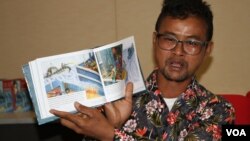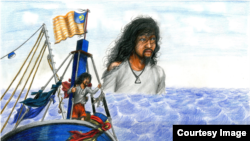A graphic novel detailing the personal experiences of a Cambodian human trafficking victim-turned artist was praised during its launch last week by activists and researchers, who said it was a unique, evocative work that would help American readers understand the need to end human trafficking.
Vannak Anan Prum, 41, a self-taught artist, drew the images for his memoir titled “The Dead Eye and The Deep Blue Sea.” It depicts his plight during a three-year and seven month-long period when he left his pregnant wife and was lured across the Cambodian border with a promise of a job and then trafficked on to a Thai fishing boat.
Once onboard, he and dozens of other poor men had little chance to escape and were forced to perform dangerous, heavy work, while being at constant risk of violent abuse from the captain and his crew.
One of the most graphic drawings in the memoir shows a worker being beheaded on a fishing boat and dumped overboard, while another depicts a headless human corpse stuck inside a fishing net on the boat.
Drawing to end trafficking
He made the book “so that organizations in all the countries, especially the ones working to prevent and fight against trafficking in persons, as well as public officials, are aware of the issue and can thus jointly prevent it,” Vannak told VOA Khmer at a book signing event at Kramerbooks & Afterwords Café in Washington D.C on May 15.
The Kampong Speu Province-born father of two said he managed a daring escape in 2010 by secretly jumping off the Thai fishing boat with a Thai co-worker in an attempt to seek help from the Malaysian police when the boat came to dock in Malaysian waters.
He said, however, that, he was “sold again by corrupt police officers” to work as a forced laborer in a Malaysian palm oil plantation for almost another year before he was eventually rescued by an NGO.
The book ends with him being named one of the U.S. Department of State’s “Heroes” in 2012 by then-Secretary of State Hillary Clinton for spreading awareness of human trafficking via his paintings.
Vannak said he would be promoting the book during several events the coming weeks.
A talented survivor
Martina E. Vandenberg, president of the Human Trafficking Legal Center in Washington, said Vannak’s story and his artistic ability to tell it were something special.
“Because of the way that he managed to show what human trafficking and forced labor actually looks like from the perspective of a survivor,” she said at the book signing.
“And it’s unusual to find a survivor who is so articulate and also so talented in terms of drawing what happened.”
She said an estimated 800,000 men are kept in similar, modern-day slavery conditions on fishing boats across the world, where they face rampant abuses and forced labor.
In Southeast Asia, the notorious Thai fishing industry uses tens of thousands of poor men from neighboring Myanmar, Cambodia and Laos, many of whom are abused for years before they are repatriated with the help of the United Nations or NGOs.
‘There’s never been a book like this’
Jocelyn Pederick, an Australian filmmaker who assisted Vannak in getting the book published by Seven Stories Press, told VOA, “There’s never been a book like this that doesn’t only tell you the story, but actually shows you what it looks like to be a worker and a slave,” she said.
“A lot of stories about trafficking, we hear ‘I was poor; I went to look for work abroad and then I was trafficked. Horrible things happened to me and somehow I escaped and came back.
“But Vannak’s book tells you every little piece of information in that story, every tiny thing and every incident that led to it,” said Pederick, who is a co-author of the book.
Even though many news stories and human rights reports have appeared in recent years about the abuses in the Thai seafood industry, activists and researchers said Vannak’s book would be an important work to teach the general public about the sector.
Raising consumer awareness
Some also said more should done so that consumers can know whether abuses occurred to make the Thai seafood products they are buying.
“You should be able to see it and know whether you spend your dollars with a company that does not have slavery in their supply chain,” said Christina Kiritz, founding CEO of Prevent Human Trafficking NGO, in an interview at George Washington University’s Elliott School of International Affairs where Vannak gave a presentation.
Sarah Rose-Jensen, a PhD candidate and lecturer at the school, echoed this view, saying, “As consumers in the U.S., we can actually put pressure on these corporations to improve their businesses’ practices. So, it’s important to understand that these products might have been produced using slave labor.”
Vannak said he still felt like conducting more public advocacy and research on the issue until governments and consumers put the abuses to an end.
“If I have a chance to go onto a fishing boat again, I will video-record all the slavery scenes that are still ongoing on fishing boats so I can broadcast it for the world to see,” he said.










